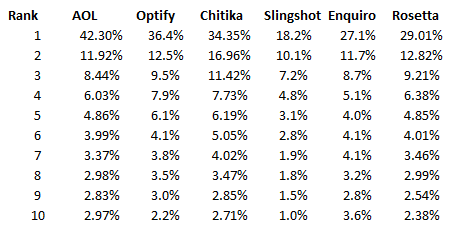Getting Your SEO Priorities Straight With The Keyword Equation

There are a lot of web pages out there competing for the #1 rank for a lot of keywords. Good SEO is all about picking your battles. You have limited resources, and seemingly unlimited competition, so you need to decide where best to target your SEO efforts and then go hard.
That’s why we use a system called The Keyword Equation to determine a keyword’s value relative to another with a figure called the Keyword Value Index.
(Yes, there’s math involved. No, it won’t hurt you.)

See, it’s a simple concept.
Now let’s add some details to the variables.
Determining Relative Keyword Benefit
Before we dig in, let’s pause on the word relative. This equation should be used after we already know how much SEO resources we’re working with. The purpose of this system is not to project ROI on SEO tactics. The purpose is to see how different keywords stack up against one another, so we can divvy up our allocated SEO resources appropriately. Thus, we’re not concerned with absolute accurate numbers on keyword value; we’re only concerned with accurately determining keyword worth relative to one another. Understanding this enables us to take shortcuts when practical and bypass the endless minutia required to get accurate absolute value projections. Unpause.
Simple Keyword Value Index Equation
Benefit of Ranking High = Visit Quantity x Visit Quality
Simple quantity times quality. So now we have:

In Excel, that would look like this:

(Note how our keyword with the most estimated visits has the lowest index. This is a frequent occurrence in real world applications. One of the benefits of the Keyword Equation is that it puts visit quantity in perspective.)
Visit Quantity
Visit Quantity = Total Searches x Click-Thru-Rate
Typically, your input for Total Searches will come in the form of “monthly query volume” from a tool such as AdWords Keyword Planner.
For Click-Thru-Rate, I often ignore it, because I’m almost always going for the #1 ranking position. Thus, the projected Click-Thru-Rate is relatively stable, and doesn’t change how Keyword Value Index numbers look relative to one another.
However, you may want to adjust Click-Thru-Rate to reflect situations like SERPs with a lot of advertisements (lower CTR for every organic position) or SERPs with a unbeatable page ranking #1 (where you may have to settle for #2). If you want to use the CTR input, the important thing is to remember exponential increases as you climb the ranks. (which is why we don’t go for #2).
Visit Quality
I like to use the term Per-Visit-Value for visit quality. It’s the average contribution to your website’s goals from a single visit for a given search query. There’s a few ways to derive a useful figure for Per-Visit-Value, depending on your situation. For example:
For e-commerce, Per-Visit-Value = Conversion Rate x Value of Sale (in lifetime profit, if desired)
For lead gen, Per-Visit-Value =Conversion Rate x Lead Close Rate x Value of Sale (in lifetime profit, if desired)
For GA pros: you can take advantage of the page value metric (my favorite metric) and use that for educated guesses, if you have sufficient data on organic or paid keywords — and if you have entered in proper goal values in Google Analytics (which you really should) or you’ve properly set-up e-commerce conversion tracking (which you really should).
If you lack sufficient quantitative data (which is often in practice), then you can make an educated guess on Per-Visit-Value by considering:
- known data for benchmarks
- relevance (of your content to the keyword)
- user intent (navigational, informational, investigative, transactional — read a classic on intent here)
Cost of Ranking High (AKA Keyword Difficulty)
Getting to #1 ain’t easy. It takes time and money to win links, make great content, and optimize your page. In addition to those resources, ranking high takes another resource — precious real estate on your site. Typically the best keywords are targeted on the home page, because that page has too much link equity and importance to be targeting scrub keywords.
There’s really no way that I know of to purely mathematically calculate the difficulty of getting to number 1 for a keyword. Instead, I like to assign a value (your scale doesn’t matter as long as you use the scale consistently) for keyword difficulty based on analysis of a combination of quantitative and qualitative factors. There are several factors that impact how difficult it will be to rank #1 for a given keyword, and the weight of each factor just depends. These factors are:
- current ranking (getting from #1 to #1 is easier than going from #100 to #1)
- ease of implementation (it’s easier to write a great page for “triple-skummeled widgets” if you already have a file on triple-skummeling and an expert on widgets than if you don’t).
- competition
Competition
That last one is the toughest part of this equation; but it’s important. The important thing is to rank the difficulty of each keyword in the analysis (again, you can use any scale you want as long as you’re consistent). Here’s an article of 35 SEO experts giving advice on measuring keyword competition. Personally, my typical way of gauging competition is:
- gauging link equity/authority of top 5 SERPs (I like the Moz difficulty tool although it’s not-free)
- gauging level of on-page keyword optimization (a scan of the Title and Description often will do)
- asking “can we make a better page on this topic than anyone else?”
Caveats
First, no matter how big the Keyword Value Index is, there’s likely a keyword difficulty level that is outside of your reach, given your current resources. If you want to push past that limit, you’ll need to get really creative.
Second, there’s more to search query segmentation than keywords. People also perform search engine queries on the basis of:
- location
- search vertical (image, video, news, etc…)
- recency (newer results vs. any results)
- device (mobile vs. non-mobile)
- social (Google+)
- personalization

When you consider these factors, you’ll be able to understand and thus target audience segments more effectively than on keywords alone. You can also break down competitive keywords into smaller, attainable segments by adding filters. For example, Joe the plumber may not be able to get his site ranking on the first page for “plumbers nationwide”, but it he should be able to do it for people searching in his hometown of Pittsburgh.
Now What?
Well now that I forced you to do math, I’ll share with you a no-frills Google Docs workbook with the Keyword Value Index calculations built in. You can make a copy of this spreadsheet to use yourself under the File menu.

Here’s the final, extended calculation, if you break it down into all the component variables:

So what can you do with this number?
There are 5 big things I like to do.
- Determine which keywords are worth targeting and which aren’t.
- Prioritize resource allocation, such as outreach and copy-writing.
- Determine what keywords need love sooner and what can wait.
- Inform site architecture, with high value keywords getting prime real estate (like the home page or pages linked to from the main menu) and lower-value keywords getting lower value real estate.
- Maintain perspective: the equation helps guide holistic, ROI-driven SEO, where high-volumes are just a piece of the puzzle.



